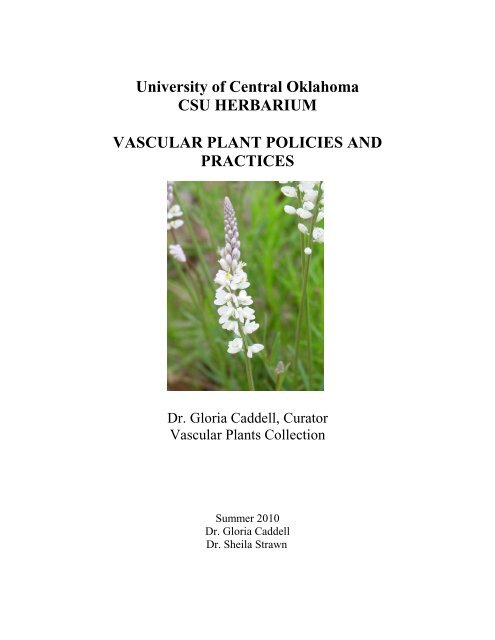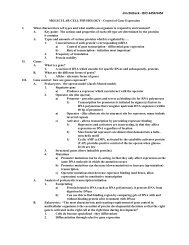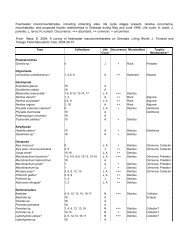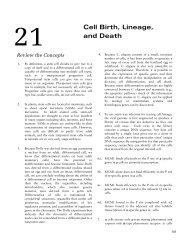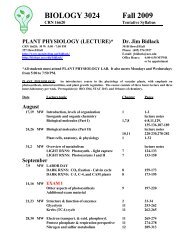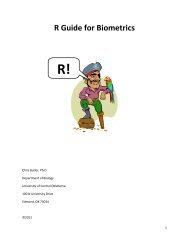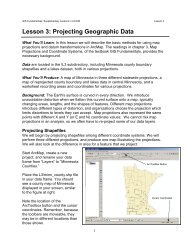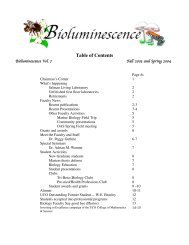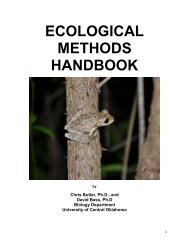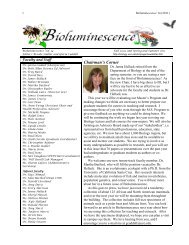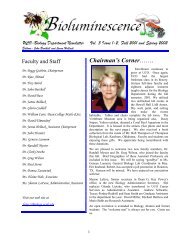uco herbarium policies and practices - Biology - University of Central ...
uco herbarium policies and practices - Biology - University of Central ...
uco herbarium policies and practices - Biology - University of Central ...
Create successful ePaper yourself
Turn your PDF publications into a flip-book with our unique Google optimized e-Paper software.
<strong>University</strong> <strong>of</strong> <strong>Central</strong> Oklahoma<br />
CSU HERBARIUM<br />
VASCULAR PLANT POLICIES AND<br />
PRACTICES<br />
Dr. Gloria Caddell, Curator<br />
Vascular Plants Collection<br />
Summer 2010<br />
Dr. Gloria Caddell<br />
Dr. Sheila Strawn
TABLE OF CONTENTS<br />
I. Overview <strong>of</strong> the Herbarium <strong>and</strong> Goals<br />
II. Purpose <strong>of</strong> this Manual<br />
III. Description <strong>of</strong> Collection<br />
IV. Location <strong>of</strong> the Herbarium<br />
V. Arrangement <strong>of</strong> Specimens<br />
VI. Funding Support<br />
VII. Access to the Collection<br />
VIII. Use <strong>of</strong> the Herbarium<br />
A. General Guidelines<br />
B. Treatment <strong>of</strong> Specimens <strong>and</strong> Biological Materials before entry<br />
into the <strong>herbarium</strong><br />
C. H<strong>and</strong>ling <strong>of</strong> Specimens<br />
D. Annotating Specimens<br />
E. Destructive Sampling Policy<br />
F. Citing the Herbarium<br />
G. Equipment Available<br />
H. Assistance with Plant Identification<br />
IX. Specimen Loans<br />
X. Collections Management<br />
A. St<strong>and</strong>ards <strong>of</strong> Pr<strong>of</strong>essional Practice <strong>and</strong> Code <strong>of</strong> Ethics<br />
B. Curator’s responsibilities<br />
C. Collection Manager’s responsibilities<br />
D. Graduate <strong>and</strong> Undergraduate Student Assistants’ responsibilities<br />
XI. Procedures for Preparation <strong>of</strong> Herbarium Specimens<br />
A. Collection, Pressing, <strong>and</strong> Drying <strong>of</strong> Specimens<br />
B. Specimen Label Preparation<br />
C. Mounting Specimens<br />
D. Packet Preparation<br />
E. Deep-freezing specimens<br />
XII. Procedures for Stamping, Accessioning, Filing, <strong>and</strong> Deaccessioning <strong>of</strong> Herbarium<br />
Specimens<br />
A. Training<br />
B. Stamping Specimens with Herbarium Accession Number<br />
C. Entering Specimen Data in Herbarium Databases<br />
D. Filing Specimens<br />
E. Data Backup<br />
F. Deaccessioning or Disposal <strong>of</strong> Specimens<br />
XIII. Protocol for Sending Data to Oklahoma Vascular Plant Database at the Oklahoma<br />
Biological Survey<br />
XIV. Protocol for Entering Data into Specify<br />
XV. Integrated Pest Management<br />
XVI. Dust Control<br />
XVII. Collection Security<br />
XVIII. Computer Use<br />
XIX. Useful References, Literature Cited, <strong>and</strong> Useful Links
I. Overview <strong>of</strong> the Herbarium <strong>and</strong> Goals<br />
The <strong>University</strong> <strong>of</strong> <strong>Central</strong> Oklahoma Herbarium, a section <strong>of</strong> the <strong>University</strong> <strong>of</strong><br />
<strong>Central</strong> Oklahoma Natural History Museum (UCONHM) houses a collection <strong>of</strong> ca.<br />
12,500 vascular <strong>and</strong> non-vascular plants. Oklahoma plants make up the majority <strong>of</strong> the<br />
specimens, <strong>and</strong> there is a growing collection representing the Cimarron Gypsum Hills <strong>of</strong><br />
northwestern Oklahoma. The Herbarium is used in several <strong>Biology</strong> courses, including<br />
Plant <strong>Biology</strong>, Plant Taxonomy, Plant Kingdom, Plant Ecology, Marine <strong>Biology</strong>, <strong>and</strong><br />
Freshwater <strong>Biology</strong>.<br />
The goals <strong>of</strong> the Herbarium are to responsibly maintain <strong>and</strong> exp<strong>and</strong> the collection,<br />
<strong>and</strong> to make specimens accessible for teaching, research, <strong>and</strong> outreach. It provides a<br />
record <strong>of</strong> the biodiversity <strong>of</strong> plants <strong>of</strong> Oklahoma, facilitates plant identification, <strong>and</strong><br />
makes specimens available for research on plant distributions, evolution, <strong>and</strong> ecology.<br />
Specimen information is available to students, researchers, <strong>and</strong> the general public. The<br />
<strong>herbarium</strong> maintains an electronic database. Specimen data are made available to the<br />
scientific community through the Oklahoma Vascular Plants Database managed by the<br />
Oklahoma Biological Survey housed at the <strong>University</strong> <strong>of</strong> Oklahoma, <strong>and</strong> through<br />
Specify.<br />
In 2004, the American Society <strong>of</strong> Plant Taxonomists issued a position statement<br />
that emphasized the importance <strong>and</strong> value <strong>of</strong> plant collections in teaching, basic <strong>and</strong><br />
applied research, <strong>and</strong> outreach, <strong>and</strong> stressed the need to support <strong>and</strong> maintain collections<br />
so that they will be available indefinitely. The text <strong>of</strong> this position statement is available<br />
at:http://www.botany.org/plantsciencebulletin/psb-2004-50-4.php#American.<br />
II. Purpose <strong>of</strong> this Manual<br />
This manual outlines the <strong>policies</strong> <strong>and</strong> guidelines for the acquisition, accessioning,<br />
maintenance <strong>and</strong> protection, loaning, deaccessioning, <strong>and</strong> use <strong>of</strong> <strong>herbarium</strong> specimens. It<br />
also describes the duties <strong>and</strong> responsibilities <strong>of</strong> <strong>herbarium</strong> personnel, <strong>and</strong> serves as a<br />
resource for student assistants <strong>and</strong> users <strong>of</strong> the <strong>herbarium</strong>.<br />
III. Description <strong>of</strong> Collection<br />
Approximately 12,500 vascular plant specimens have been accessioned <strong>and</strong> are<br />
filed in 18 metal storage cabinets. Algae, mosses <strong>and</strong> lichens are contained in 1 metal<br />
storage cabinet. The vast majority (almost 90%) <strong>of</strong> specimens in the collection are <strong>of</strong><br />
vascular plants collected in Oklahoma. Most specimens were collected by students<br />
enrolled in BIO 4294 <strong>and</strong> 5294 Plant Taxonomy. Other specimens include personal<br />
collections <strong>of</strong> faculty, voucher specimens <strong>of</strong> research done by faculty <strong>and</strong> students, <strong>and</strong><br />
specimens received from other herbaria. There is also a small medicinal plants<br />
collection.
IV. Location <strong>of</strong> Herbarium<br />
UCO’s Herbarium, designated CSU in Index Herbariorum, is located in Room<br />
LAB 152 <strong>of</strong> Howell Hall on the campus <strong>of</strong> the <strong>University</strong> <strong>of</strong> <strong>Central</strong> Oklahoma.<br />
V. Arrangement <strong>of</strong> Specimens<br />
Specimens are currently filed alphabetically by family. Within each family the<br />
genera <strong>and</strong> species are arranged in alphabetical order. Specimens from Oklahoma are<br />
filed in manila folders, those from other states are in green folders, those from other<br />
countries are in orange folders, <strong>and</strong> cultivated plants are in yellow folders.<br />
VI. Funding Support<br />
Facilities are provided by UCO, supplies are provided through student fees, <strong>and</strong><br />
equipment is purchased through grants <strong>and</strong> research funds. The College <strong>of</strong> Math <strong>and</strong><br />
Science provides release time for the Curator <strong>and</strong> funds for student workers.<br />
VII. Access to the Herbarium<br />
We welcome UCO faculty <strong>and</strong> students, <strong>and</strong> other researchers <strong>and</strong> visitors to the<br />
Herbarium, but please contact the Curator to obtain permission to access the <strong>herbarium</strong><br />
collections for teaching or research. All users should follow the usage guidelines in this<br />
manual. First-time visitors who use the collections will be provided with information on<br />
the location <strong>and</strong> arrangement <strong>of</strong> specimens, availability <strong>of</strong> references <strong>and</strong> workspaces,<br />
<strong>and</strong> safety procedures. Requests from <strong>of</strong>f-campus individuals to visit or tour the<br />
<strong>herbarium</strong> should be by mail or e-mail to Dr. Gloria Caddell, Department <strong>of</strong> <strong>Biology</strong>, U.<br />
<strong>of</strong> <strong>Central</strong> Oklahoma, Edmond, OK 73034 or gcaddell@<strong>uco</strong>.edu.<br />
VIII. Use <strong>of</strong> the Herbarium<br />
Users should follow these guidelines:<br />
A. General Guidelines<br />
• Abide by conservation <strong>and</strong> safety regulations posted in the <strong>herbarium</strong>.<br />
• Ask for assistance, if needed, with locating specimens.<br />
• Smoking <strong>and</strong> tobacco products are prohibited in the <strong>herbarium</strong>.<br />
• No food or drinks are allowed in the <strong>herbarium</strong>.<br />
• Herbarium specimens should be treated for pests before being brought from the<br />
prep room into the <strong>herbarium</strong>.<br />
• Biological materials (books, paper) should be treated for pests before being<br />
brought into the <strong>herbarium</strong>.<br />
• Lights should be turned <strong>of</strong>f when the <strong>herbarium</strong> is unoccupied.<br />
• Visitors are requested to sign the guestbook.
B. Treatment <strong>of</strong> Specimens <strong>and</strong> Biological Materials before entry into the<br />
<strong>herbarium</strong><br />
• All specimens <strong>and</strong> biological materials should be deep frozen for at least 48 hours<br />
to kill pests before they are brought into the <strong>herbarium</strong>.<br />
C. H<strong>and</strong>ling <strong>of</strong> Specimens<br />
• H<strong>and</strong>s should be clean before h<strong>and</strong>ling specimens.<br />
• Gently open <strong>and</strong> close the cabinets.<br />
• Use two h<strong>and</strong>s to remove <strong>and</strong> carry folders; carry folders in a horizontal position.<br />
• Support specimens with both h<strong>and</strong>s, keeping them in a horizontal position (face<br />
up). Do not turn them over like pages <strong>of</strong> a book.<br />
• If you need to retrieve a specimen or specimens from the middle <strong>of</strong> a stack <strong>of</strong><br />
specimens within a folder, pick up stacks <strong>of</strong> several specimens at a time <strong>and</strong> place<br />
them to the side until you reach the desired specimen(s).<br />
• Do not remove specimens from the <strong>herbarium</strong> without permission <strong>of</strong> the Curator.<br />
• Do not photograph or photocopy specimens without permission from the Curator.<br />
• Do not remove any plant parts from <strong>herbarium</strong> specimens without permission<br />
from the Curator.<br />
• If material comes loose as you h<strong>and</strong>le a specimen, place it in a packet on the<br />
sheet; notify <strong>herbarium</strong> staff if the sheet lacks packets.<br />
• Notify <strong>herbarium</strong> staff <strong>of</strong> any evidence <strong>of</strong> insects or <strong>of</strong> recent insect damage to<br />
specimens.<br />
• Notify the Curator <strong>of</strong> any misidentified or misfiled specimens, or specimens in<br />
need <strong>of</strong> repair.<br />
• Keep <strong>herbarium</strong> cabinet doors closed unless you are removing specimens from<br />
them.<br />
• Do not leave specimens out <strong>of</strong> cabinets overnight.<br />
• Exercise extreme care if you re-file specimens to ensure they are filed in their<br />
proper place. The Herbarium staff can re-file specimens if needed.<br />
• Wash h<strong>and</strong>s after h<strong>and</strong>ling specimens.<br />
D. Annotating Specimens<br />
Annotations by experts <strong>and</strong> by the Curator should be h<strong>and</strong>written in permanent<br />
ink or typed on archival annotation labels. The scientific name, its author, the annotator’s<br />
name <strong>and</strong> the date should be on the annotation label. The format for annotation labels is<br />
in a file on the <strong>herbarium</strong> computer. Labels should be glued above the specimen label. If<br />
needed, the <strong>herbarium</strong> staff can assist with this.<br />
E. Destructive Sampling Policy<br />
Researchers wishing to remove samples from <strong>herbarium</strong> specimens for DNA<br />
analysis, etc. need to obtain prior permission from the Curator.
F. Citing the Herbarium<br />
When specimens from the collection are cited in a research publication, the Index<br />
Herbariorum designation “CSU” should be cited. Clarification <strong>of</strong> location may be<br />
necessary, because it differs from the <strong>University</strong>’s acronym “UCO”.<br />
G. Equipment Available<br />
Plant presses, plant dryers, dissecting microscopes <strong>and</strong> tools, folders, <strong>and</strong> labels<br />
are available. The Curator, Collections Manager, <strong>and</strong> Student Assistants can provide<br />
help to persons needing to use these items.<br />
H. Assistance with Plant Identification<br />
If available, the Curator or student assistants will be pleased to assist with plant<br />
identifications.<br />
IX. Specimen Loans<br />
Researchers associated with any <strong>herbarium</strong> may request a loan <strong>of</strong> specimens.<br />
Contact the Curator, stating the name <strong>of</strong> the project <strong>and</strong> the taxa <strong>of</strong> interest, <strong>and</strong> ask for a<br />
loan request form. Upon its return, the specimens will be shipped. We expect specimens<br />
to be protected from pests during the loan period. Loans may be granted for up to one<br />
year with permission from the Curator.<br />
A log <strong>of</strong> incoming <strong>and</strong> outgoing loans is available on the <strong>herbarium</strong> computer.<br />
This should be updated each time a loan is processed. Hard copies <strong>of</strong> loan records should<br />
also be filed. The loan database should be queried annually <strong>and</strong> notice sent to borrowers<br />
regarding outst<strong>and</strong>ing loans.<br />
When outgoing loans are taken from the cabinet, a tag should be placed in the<br />
cabinet indicating the location to which the specimens were loaned. Damaged specimens<br />
should be repaired before shipment. Sheets should be placed between rigid cardboards,<br />
<strong>and</strong> tied with twine. Pack boxes securely with packing material so that they do not shift<br />
or rub against each other. Include a packing list <strong>and</strong> number boxes (i.e. “1 <strong>of</strong> 3”).<br />
Within UCO only verbal permission is necessary for faculty to temporarily<br />
remove specimens from the <strong>herbarium</strong> for use in class, for an <strong>of</strong>f-campus presentation,<br />
etc. However the loan <strong>and</strong> a record <strong>of</strong> verbal permission must be recorded in the<br />
database.<br />
X. Collections Management<br />
A. St<strong>and</strong>ards <strong>of</strong> pr<strong>of</strong>essional practice <strong>and</strong> Code <strong>of</strong> Ethics<br />
Herbarium <strong>practices</strong> will follow st<strong>and</strong>ards <strong>and</strong> guidelines in the Code <strong>of</strong> Ethics <strong>of</strong><br />
the International Committee <strong>of</strong> <strong>University</strong> Museums <strong>and</strong> Collections, a committee <strong>of</strong> the<br />
International Council <strong>of</strong> Museums. The Code <strong>of</strong> Ethics is available at:<br />
http://icom.museum/ethics.html.
All individuals associated with the <strong>herbarium</strong> will:<br />
• protect <strong>and</strong> conserve the <strong>herbarium</strong> specimens because they are irreplaceable<br />
• facilitate the use <strong>of</strong> the <strong>herbarium</strong> specimens for teaching <strong>and</strong> research<br />
• use the most acceptable methods <strong>of</strong> conservation <strong>and</strong> management<br />
• strive to improve the scientific <strong>and</strong> educational value <strong>of</strong> the collection<br />
• use good judgment about dissemination <strong>of</strong> information that could jeopardize rare<br />
or endangered plants<br />
• deny access to users who fail to follow the <strong>policies</strong> in this manual<br />
• clearly identify any specimens that are hazardous or have been treated with<br />
chemicals that make them unsafe to h<strong>and</strong>le.<br />
B. Curator’s responsibilities<br />
The Curator <strong>of</strong> the <strong>herbarium</strong> is a faculty member <strong>of</strong> the Department <strong>of</strong> <strong>Biology</strong><br />
with experience collecting, identifying, <strong>and</strong> mounting plant specimens. Currently Dr.<br />
Gloria Caddell is the Curator <strong>of</strong> the collection. The Curator is responsible for the<br />
collection <strong>and</strong> accessioning <strong>of</strong> specimens, <strong>herbarium</strong> <strong>policies</strong> <strong>and</strong> procedures, <strong>and</strong><br />
maintenance <strong>of</strong> a digital database that is periodically uploaded to the Oklahoma Vascular<br />
Plants Database <strong>and</strong> to Specify. The Curator collaborates with the Collections Manager<br />
<strong>and</strong> together they supervise the work <strong>of</strong> the student assistants.<br />
C. Collections Manager’s responsibilities<br />
The Collections Manager <strong>of</strong> the UCO Natural History Museum has training in<br />
specimen preservation, works to maintain the integrity <strong>and</strong> quality <strong>of</strong> the collection under<br />
the supervision <strong>of</strong> the curator, <strong>and</strong> supervises student assistants in the management <strong>and</strong><br />
maintenance <strong>of</strong> the collection. The Collections Manager attends meetings <strong>and</strong> workshops,<br />
as needed, to remain current on <strong>herbarium</strong> <strong>practices</strong>. Ms. Lynda Loucks is the current<br />
Collections Manager.<br />
D. Graduate or Undergraduate Student Assistants’ responsibilities<br />
Undergraduate or graduate students, trained by <strong>and</strong> under the direct supervision <strong>of</strong> the<br />
Collections Manager or Curator, mount, accession, <strong>and</strong> file specimens, <strong>and</strong> carry out<br />
other duties assigned by the Curator, Manager or other botany faculty member. Some<br />
tasks <strong>of</strong> the student assistants are to:<br />
• Sweep <strong>and</strong> remove debris <strong>and</strong> dust from surfaces in the <strong>herbarium</strong> <strong>and</strong> prep room.<br />
• Check insect traps & report results to the Collections Manager or Curator.<br />
• Mount plants.<br />
• Serial stamp <strong>and</strong> accession specimens.<br />
• Enter specimen data into Specify.<br />
• Deep-freeze specimens if needed.<br />
• File specimens in <strong>herbarium</strong> collection.
• Clean sink.<br />
• Discard trash <strong>and</strong> unusable paper products.<br />
• Record hours worked, <strong>and</strong> indicate tasks completed.<br />
XI. Procedures for Preparation <strong>of</strong> Herbarium Specimens<br />
A. Collection, Pressing, <strong>and</strong> Drying <strong>of</strong> Specimens<br />
Specimens deposited in the <strong>herbarium</strong> are collected, pressed in a plant press, <strong>and</strong><br />
dried in the plant dryer located in the <strong>herbarium</strong> prep room. Before collecting plant<br />
specimens, the following should be considered:<br />
• Permission from the appropriate agency or individual is needed for collecting<br />
specimens on private property, in national parks, national wildlife refuges, state<br />
parks, local parks, l<strong>and</strong>s owned by the Nature Conservancy, etc.<br />
• Always consider that removal <strong>of</strong> a plant from a population could have serious<br />
consequences for the population. Be aware <strong>of</strong> plants that are rare or endangered,<br />
<strong>and</strong> never collect them. Many taxonomists follow the 1 in 20 rule, i.e. don’t<br />
collect a plant unless there are at least 20 plants <strong>of</strong> the same species in the<br />
population.<br />
• All specimens to be deposited in the <strong>herbarium</strong> should have complete collection<br />
data associated with them: country; state; county; scientific name; exact location<br />
(city, name <strong>of</strong> park, etc.; road, with distance from intersection with another road,<br />
mile marker, etc.; Township, Range, <strong>and</strong> Section Number; latitude <strong>and</strong> longitude<br />
or Global Positioning System – GPS- location if possible); habitat; elevation;<br />
associated species; size if a woody plant; abundance; a note <strong>of</strong> any traits that may<br />
change with drying, e.g. color or odor; collector’s name; collection number; <strong>and</strong><br />
collection date. Specimens collected by a particular collector are numbered<br />
sequentially throughout the lifetime <strong>of</strong> the collector. Duplicates <strong>of</strong> a specimen<br />
(collected on the same date at the exact same location) are given the same<br />
collection number.<br />
• The collector’s notebook, or copies <strong>of</strong> pertinent pages out <strong>of</strong> the notebook, should<br />
be deposited in the <strong>herbarium</strong>.<br />
• Herbaceous plants should have underground parts – roots, rhizomes, bulbs, etc.<br />
• All specimens should be in reproductive condition; flowering plants should have<br />
flowers, fruits, or both.<br />
• The more quickly plants are pressed after they are collected, the higher the quality<br />
<strong>of</strong> the specimen. If plants are not pressed immediately, they should be wrapped in<br />
moist newspaper, placed in a plastic bag, <strong>and</strong> kept cool (preferably in an ice chest<br />
or refrigerator) until they can be pressed.
Directions for pressing plants are as follows:<br />
• Within a plant press, which consists <strong>of</strong> a pair <strong>of</strong> wooden frames, specimens are<br />
placed in folded newspaper s<strong>and</strong>wiched between blotters, <strong>and</strong> then between<br />
corrugated cardboard ventilators.<br />
• The specimen should fit into a space no larger than 11 x 16 inches so that it will<br />
fit on a sheet <strong>of</strong> mounting paper.<br />
• Large plants may need to be pressed in more than one piece <strong>of</strong> folded newspaper.<br />
• The collection number is written on the newsprint.<br />
• Specimens may be trimmed, but all parts should be represented.<br />
• Specimens may be folded, <strong>and</strong> if necessary the folds may be secured with a<br />
notecard with a slit into which the fold is inserted. This technique is particularly<br />
useful for grasses.<br />
• The plant press straps should be tightened as much as possible. During drying, the<br />
plant press straps should be checked <strong>and</strong> tightened daily.<br />
• Specimens are generally dried at 105-110 o F. for at least three days. Specimens<br />
should be thoroughly dried before they are mounted; thick or succulent plant parts<br />
may take longer than three days to dry.<br />
• A good reference for preparing plant specimens for deposit in a <strong>herbarium</strong> can be<br />
found at: http://www.flmnh.ufl.edu/<strong>herbarium</strong>/voucher.htm.<br />
B. Specimen Label Preparation<br />
A label template is in a file on the <strong>herbarium</strong> computer. Labels should include the<br />
following collection data:<br />
• Country, state, county<br />
• Scientific name <strong>and</strong> author<br />
• Exact location (city, name <strong>of</strong> park, etc.; road, with distance from intersection with<br />
another road, mile marker, etc.; Township, Range, <strong>and</strong> Section Number; latitude<br />
<strong>and</strong> longitude or Global Positioning System – GPS- location if possible)<br />
• Habitat<br />
• Elevation<br />
• Associated species<br />
• Size if a woody plant<br />
• Relative abundance<br />
• Description <strong>of</strong> any traits that may change with drying, e.g. color or odor<br />
• Collector name<br />
• Collection number (if a single plant has been mounted on more than one sheet,<br />
then after the collection number this is indicated by adding “1 <strong>of</strong> 2”, “2 <strong>of</strong> 2”,<br />
“1 <strong>of</strong> 3” etc.)<br />
• Collection date<br />
Specimen labels should be printed on acid-free paper. Examples <strong>of</strong> <strong>herbarium</strong><br />
labels can be found at: http://www.flmnh.ufl.edu/<strong>herbarium</strong>/voucher.htm
C. Mounting Specimens<br />
Before specimens are mounted, the Curator or Collections Manager will approve<br />
the mounting <strong>of</strong> all specimens to ensure that they were legally collected, in reproductive<br />
condition, free <strong>of</strong> mold, <strong>and</strong> are <strong>of</strong> high quality. Specimens are mounted on st<strong>and</strong>ardsized<br />
(11.5 X16.5 inches) archival, acid-free paper.<br />
Procedures for mounting specimens are as follows:<br />
.<br />
1. Pour archival quality, clear drying white glue or Elmer’s ® glue onto a glass<br />
plate, adding water to thin it until it is the consistency <strong>of</strong> milk. Using a paintbrush, spread<br />
the glue over the glass.<br />
2. Place a piece <strong>of</strong> mounting paper on a cardboard ventilator.<br />
3. Using an acid-free white glue stick or undiluted white glue, glue the specimen<br />
label in the lower right h<strong>and</strong> corner.<br />
4. Before gluing the specimen, aesthetically arrange it on the mounting paper so<br />
that there is white space around the specimen. The best side <strong>of</strong> the specimen should face<br />
up, but try to expose upper <strong>and</strong> lower leaf surfaces, flowers, <strong>and</strong> fruits. Trim excess<br />
branches so that branches do not overlap. If the plants are small, more than one specimen<br />
may be glued to a sheet. Leave room for annotation labels above the specimen label, <strong>and</strong><br />
space for the specimen’s serial stamp in the upper left corner.<br />
5. If a specimen must be split onto two or more sheets, the label should indicate,<br />
after the collector’s number, that the sheets are “1 <strong>of</strong> 2,” “2 <strong>of</strong> 2, “ “1 <strong>of</strong> 3, ” etc.<br />
6. Extra flowers <strong>and</strong> fruits may be placed in a packet (see packet instructions<br />
below) attached to the mounting paper.<br />
7. Large specimens may be folded into a “V” or “W” to fit the sheet.<br />
8. Lift the specimen from the mounting paper <strong>and</strong> push it completely into the glue<br />
on the glass plate using a pair <strong>of</strong> tweezers, probe, or small card. Pick the specimen up<br />
with a pair <strong>of</strong> tweezers, <strong>and</strong> add glue to the underside with a small paintbrush if needed to<br />
ensure that the entire underside is covered. Then carefully lay the specimen on the sheet<br />
in the position planned earlier, <strong>and</strong> do not move it! Dust will adhere to any glue exposed<br />
on the paper by moving a specimen.<br />
9. Cover the specimen with waxed paper. Use lead weights, if necessary, to<br />
weigh down parts that don’t lay flat. Place a piece <strong>of</strong> blotter paper on top <strong>of</strong> the waxed<br />
paper, then a cardboard ventilator.<br />
10. Place a piece <strong>of</strong> mounting paper for the next specimen on the cardboard, <strong>and</strong><br />
continue as above.
12. Books may be placed on top <strong>of</strong> the stack <strong>of</strong> mounted specimens to apply<br />
pressure for about 24 hours.<br />
13. For specimens with stems that do not stay glued down after following the<br />
above procedures, a strip <strong>of</strong> glue may be placed from one side to the other across the<br />
stem. Place the mounted specimen on a cardboard ventilator, add the strip <strong>of</strong> glue, then<br />
place small wooden blocks near the corner <strong>of</strong> the mounting paper to keep the glue from<br />
contacting the cardboard above it. Place a cardboard ventilator on the blocks, then place<br />
the next specimen on top <strong>of</strong> the cardboard ventilator <strong>and</strong> continue. Let glue dry for 24<br />
hours.<br />
D. Packet Preparation<br />
When small pieces <strong>of</strong> material are or become detached from the specimen, fold<br />
packets to hold those small pieces <strong>of</strong> specimens according to The Herbarium H<strong>and</strong>book<br />
3 rd ed. (Bridson <strong>and</strong> Forman,1998). Use the alternative economic version made from a<br />
rectangle <strong>of</strong> acid-free paper. Glue only the center <strong>of</strong> the back side <strong>of</strong> the packet so that all<br />
edges are free to manipulate without damage to the specimen inside.<br />
E. Deep-freezing Specimens<br />
After the specimens <strong>and</strong> their labels have been mounted on the <strong>herbarium</strong> sheet,<br />
the specimens should be frozen for 72 hours at -30 o C as recommended by The Herbarium<br />
H<strong>and</strong>book 3 rd ed. (Bridson <strong>and</strong> Forman, 1998) before being accessioned <strong>and</strong> filed in the<br />
<strong>herbarium</strong>. The specimens should be placed in extra-large plastic bags that can be tightly<br />
zipped closed before placing them in the freezer. After 72 hours the specimens are taken<br />
immediately to the <strong>herbarium</strong>, <strong>and</strong> after returning to room temperature (approximately 1<br />
hour), are accessioned <strong>and</strong> filed, or placed in a temporary <strong>herbarium</strong> cabinet until they<br />
can be accessioned.<br />
XII. Procedures for Stamping, Accessioning, Filing, <strong>and</strong> Deaccessioning<br />
<strong>of</strong> Herbarium Specimens<br />
A. Training<br />
A PowerPoint presentation detailing accession procedures, <strong>and</strong> prepared by<br />
student assistant Jocelyn Bidlack, is available on the Desktop <strong>of</strong> the <strong>herbarium</strong> computer.<br />
All personnel accessioning specimens should carefully read it <strong>and</strong> follow the<br />
accessioning procedures.<br />
B. Stamping Specimens with Herbarium Accession Number<br />
Mounted specimens will be accepted for accession as directed by the curator. The<br />
serial number is stamped with the <strong>University</strong>’s name <strong>and</strong> the Index Herbariorum<br />
designation “CSU”. Check the databases for the last used number. The last used number
should also be indicated on a card next to the stamp. Check that the serial stamp is turned<br />
to the next succeeding number. Stamp the specimen’s serial number in the upper left<br />
corner <strong>of</strong> the <strong>herbarium</strong> sheet. If there is no room, stamp it in the right-h<strong>and</strong> corner. If<br />
there is no room in either corner, stamp it anywhere on the sheet there is enough room,<br />
except above the label. That area should be reserved for annotation labels. Any<br />
specimens marked “1 <strong>of</strong> 2,” “2 <strong>of</strong> 2,” etc. should receive the same serial number. When<br />
specimens come from other collections <strong>and</strong> already have a serial number from that<br />
<strong>herbarium</strong>, our serial number should be stamped as close as attractively possible to it.<br />
Set aside any specimens in need <strong>of</strong> repair in a separate stack marked “Repair” as you<br />
stamp.<br />
C. Entering Specimen Data in Herbarium Databases<br />
All specimens are entered into an Excel database on the <strong>herbarium</strong> computer.<br />
There are four databases:<br />
“CSU Collections” for Oklahoma specimens,<br />
“CSU Collections out <strong>of</strong> state” for specimens collected in other states,<br />
“CSU Collections out <strong>of</strong> country” for specimens collected in other countries,<br />
<strong>and</strong> “CSU Collections cultivated” for cultivated plant specimens.<br />
The Excel worksheet includes columns for identification numbers <strong>of</strong> each specimen after<br />
it has been entered into Specify <strong>and</strong> into the Oklahoma Vascular Plants Database<br />
(OVPD). It is not necessary to enter these numbers as specimens are accessioned into the<br />
<strong>herbarium</strong>; they can be entered after the specimens are entered into Specify <strong>and</strong> the<br />
OVPD. Data entered into the Excel Databases are as follows: Country, State, County;<br />
Scientific Name; USDA Symbol; Locality; Township, Range, <strong>and</strong> Section Number;<br />
Habitat; Morphology; Associated Species; Collector; Collector’s Number; <strong>and</strong> Collection<br />
Date. If the specimen has been annotated, the original scientific name <strong>and</strong> USDA symbol<br />
are also entered.<br />
D. Filing Specimens<br />
Accessioned specimens, as well as returned loans or specimens removed for<br />
study, can be filed alphabetically by family, genus, <strong>and</strong> species into the <strong>herbarium</strong><br />
cabinets. It saves time if specimens are first sorted into Oklahoma specimens, out-<strong>of</strong><br />
state specimens, out-<strong>of</strong>-country specimens, type specimens, <strong>and</strong> cultivated specimens,<br />
then by family, genus, <strong>and</strong> species. Specimens from Oklahoma are filed in manila<br />
folders, those from other states in green folders, those from out-<strong>of</strong>-country in orange<br />
folders, <strong>and</strong> cultivated plants in yellow folders. Note that “escapes” are not considered<br />
cultivated!<br />
As specimens are filed, the following guidelines should be followed:<br />
1. Carefully h<strong>and</strong>le specimens; always keep them in a horizontal position.
2. Do not fill folders thicker than 1-1/2 inches. If there is more than one folder<br />
for a species, put the specimen into the thinnest folder.<br />
3. Rearrange folders in a cabinet if needed because shelves are becoming too<br />
full; notify the Curator or Collection Manager if a cabinet is becoming too full.<br />
4. Make <strong>and</strong> label new family <strong>and</strong> genus folders as needed. If a new genus folder<br />
is needed, be sure that corrections are made to other genus folders so that<br />
the specific epithets <strong>of</strong> the specimens within each folder are correctly indicated<br />
on the labels. If you cannot find a folder for a genus, check to be sure<br />
it has not been misfiled on an adjacent shelf. Inform the Curator when a new<br />
genus cover is made.<br />
5. Watch for misfiled specimens <strong>and</strong> folders, <strong>and</strong> place them in their appropriate<br />
locations.<br />
6. Watch for any evidence <strong>of</strong> insect infestation; immediately report it to the<br />
Collections Manager <strong>and</strong> Curator <strong>and</strong> take steps outlined under “Integrated Pest<br />
Management” in this manual.<br />
E. Data Backup<br />
Each week the specimen databases are copied to a flash drive that is stored in a<br />
firepro<strong>of</strong> safe in the Mammal section <strong>of</strong> the UCONHM.<br />
F. Deaccessioning or disposal <strong>of</strong> specimens<br />
Curators, Student Assistants, or the Collections Manager may propose the<br />
removal <strong>of</strong> a specimen from the collection due to its deterioration, duplication, or lack <strong>of</strong><br />
adequate data. With approval from the Curator, duplicate specimens may be exchanged<br />
with herbaria <strong>of</strong> other institutions, donated to the teaching collection, or discarded. The<br />
Curator may designate that specimens with inadequate data or duplicates may be used in<br />
teaching labs where details <strong>of</strong> collection are not pertinent. Deteriorated specimens may be<br />
discarded with the approval <strong>of</strong> the Curator <strong>and</strong> the Collection Manager should see that the<br />
specimen’s data are removed from the database or a note is added that the specimen has<br />
been deaccessioned.<br />
XIII. Protocol for Sending Data to Oklahoma Vascular Plant Database<br />
Periodically, data entry will be uploaded to the Oklahoma Biological Survey’s<br />
Oklahoma Vascular Plants Database according to their specifications. It will be<br />
retrievable from computers at UCO.
XIV. Protocol for Entering Data into Specify<br />
A PowerPoint presentation on entering data into Specify, prepared by student<br />
worker Jocelyn Bidlack, is available on the <strong>herbarium</strong> computer. All personnel beig<br />
trained to enter data into Specify should read it. Anyone entering data into Specify will<br />
first be trained by the Collections Manager <strong>and</strong>/or the Curator.<br />
XV. Integrated Pest Management<br />
Cabinets must be free <strong>of</strong> debris <strong>and</strong> evidence <strong>of</strong> insects. Insect traps are to be set<br />
<strong>and</strong> replaced as directed on containers. Traps should be checked weekly. To help prevent<br />
insect infestations, specimens should not be left out <strong>of</strong> cabinets when not in use, <strong>and</strong><br />
should never be left out overnight. When insect evidence is observed (insects or insect<br />
parts, parts that have apparently been eaten, or powdered material), the Curator <strong>and</strong><br />
Collections Manager should be notified. The cabinet will be thoroughly cleaned, <strong>and</strong> its<br />
contents deep-frozen. Place a sign in the cabinet that says “specimens in freezer”. Then<br />
the cabinet should be fumigated with “Tri-die” or other pyrethrin <strong>and</strong> silica gel. Place an<br />
insect trap in the bottom <strong>of</strong> the cabinet. In 72 hours, check the insect traps <strong>and</strong> if there are<br />
no signs <strong>of</strong> pests, place the specimens from the freezer back into the cabinet.<br />
Some families should be particularly monitored because they are more attractive<br />
than others to insect pests (Bridson <strong>and</strong> Forman, 1998): Asteraceae, Asclepiadaceae,<br />
Apocynaceae, Apiaceae, Brassicaceae, Ericaceae, Capparaceae, Caprifoliaceae,<br />
Valerianaceae.<br />
XVI. Dust Control<br />
Herbarium surfaces should be dusted <strong>and</strong> swept twice weekly in addition to<br />
housekeeping services’ scheduled maintenance. The prep room will be maintained by<br />
housekeeping services <strong>and</strong> swept or dusted by <strong>herbarium</strong> staff as needed.<br />
XVII. Collection Security<br />
The prep room <strong>and</strong> <strong>herbarium</strong> will be locked whenever they are not occupied.<br />
XVIII. Computer Use<br />
Use <strong>of</strong> the computer in the prep room <strong>of</strong> the <strong>herbarium</strong> is limited to the<br />
Herbarium Manager, Curators, <strong>and</strong> student assistants. The computer should be used only<br />
for work associated with the <strong>herbarium</strong>.
XIX. Useful References, Literature Cited, <strong>and</strong> Useful Links<br />
Bridson, Diane, <strong>and</strong> Leonard Forman, (eds.)1998. The Herbarium H<strong>and</strong>book. 3 rd ed.<br />
Royal Botanic Gardens, Kew.<br />
Bailey Herbarium, College <strong>of</strong> Saint Benedict <strong>and</strong> St. John’s <strong>University</strong>. 2009. Accessed<br />
at http://www1.csbsju.edu/<strong>herbarium</strong> on August 15, 2010.<br />
Metsger, Deborah A. <strong>and</strong> Sheila C. Byers, eds. 1999. Managing the modern <strong>herbarium</strong>.<br />
Society for the Preservation <strong>of</strong> Natural History Collections, Washington, DC.<br />
Oklahoma Vascular Plants Database (OVPD).<br />
http://www.biosurvey.ou.edu/atlasdesc.html<br />
Open Herbarium. Accessed at<br />
http://<strong>herbarium</strong>.usu.edu/OpenHerbarium/plant%20collecting.htm on August 19, 2010.<br />
Robert Bebb Herbarium <strong>of</strong> the <strong>University</strong> <strong>of</strong> Oklahoma. Accessed at<br />
http://www.biosurvey.ou.edu/bebb/bebbhome.html on August 15, 2010.<br />
Snow, Neil. 2005. Successfully curating smaller herbaria <strong>and</strong> natural history collections<br />
in academic settings. BioScience 55(9): 771-779.<br />
<strong>University</strong> <strong>of</strong> Florida Herbarium. Preparation <strong>of</strong> plant specimens for deposit as<br />
<strong>herbarium</strong> vouchers. Accessed at http://www.flmnh.ufl.edu/<strong>herbarium</strong>/voucher.htm on<br />
August 19, 2010.<br />
<strong>University</strong> <strong>of</strong> North Carolina Herbarium.2010. Accessed at<br />
http://www.<strong>herbarium</strong>.unc.edu on August 15, 2010


